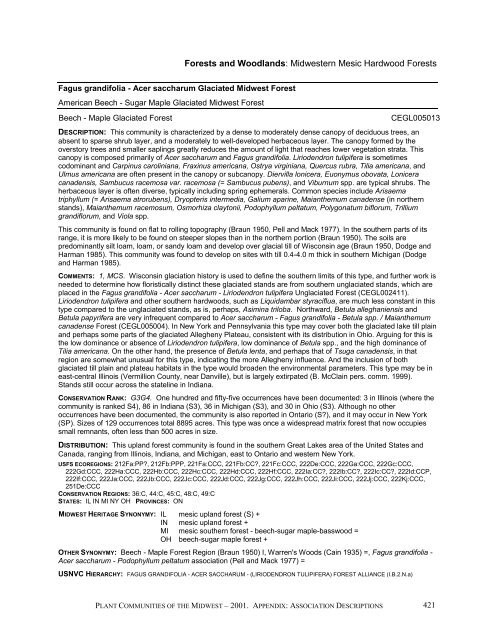Ohio subset of Plant Communities of the Midwest ... - NatureServe
Ohio subset of Plant Communities of the Midwest ... - NatureServe
Ohio subset of Plant Communities of the Midwest ... - NatureServe
Create successful ePaper yourself
Turn your PDF publications into a flip-book with our unique Google optimized e-Paper software.
Forests and Woodlands: <strong>Midwest</strong>ern Mesic Hardwood Forests<br />
Fagus grandifolia - Acer saccharum Glaciated <strong>Midwest</strong> Forest<br />
American Beech - Sugar Maple Glaciated <strong>Midwest</strong> Forest<br />
Beech - Maple Glaciated Forest<br />
CEGL005013<br />
DESCRIPTION: This community is characterized by a dense to moderately dense canopy <strong>of</strong> deciduous trees, an<br />
absent to sparse shrub layer, and a moderately to well-developed herbaceous layer. The canopy formed by <strong>the</strong><br />
overstory trees and smaller saplings greatly reduces <strong>the</strong> amount <strong>of</strong> light that reaches lower vegetation strata. This<br />
canopy is composed primarily <strong>of</strong> Acer saccharum and Fagus grandifolia. Liriodendron tulipifera is sometimes<br />
codominant and Carpinus caroliniana, Fraxinus americana, Ostrya virginiana, Quercus rubra, Tilia americana, and<br />
Ulmus americana are <strong>of</strong>ten present in <strong>the</strong> canopy or subcanopy. Diervilla lonicera, Euonymus obovata, Lonicera<br />
canadensis, Sambucus racemosa var. racemosa (= Sambucus pubens), and Viburnum spp. are typical shrubs. The<br />
herbaceous layer is <strong>of</strong>ten diverse, typically including spring ephemerals. Common species include Arisaema<br />
triphyllum (= Arisaema atrorubens), Dryopteris intermedia, Galium aparine, Maian<strong>the</strong>mum canadense (in nor<strong>the</strong>rn<br />
stands), Maian<strong>the</strong>mum racemosum, Osmorhiza claytonii, Podophyllum peltatum, Polygonatum biflorum, Trillium<br />
grandiflorum, and Viola spp.<br />
This community is found on flat to rolling topography (Braun 1950, Pell and Mack 1977). In <strong>the</strong> sou<strong>the</strong>rn parts <strong>of</strong> its<br />
range, it is more likely to be found on steeper slopes than in <strong>the</strong> nor<strong>the</strong>rn portion (Braun 1950). The soils are<br />
predominantly silt loam, loam, or sandy loam and develop over glacial till <strong>of</strong> Wisconsin age (Braun 1950, Dodge and<br />
Harman 1985). This community was found to develop on sites with till 0.4-4.0 m thick in sou<strong>the</strong>rn Michigan (Dodge<br />
and Harman 1985).<br />
COMMENTS: 1, MCS. Wisconsin glaciation history is used to define <strong>the</strong> sou<strong>the</strong>rn limits <strong>of</strong> this type, and fur<strong>the</strong>r work is<br />
needed to determine how floristically distinct <strong>the</strong>se glaciated stands are from sou<strong>the</strong>rn unglaciated stands, which are<br />
placed in <strong>the</strong> Fagus grandifolia - Acer saccharum - Liriodendron tulipifera Unglaciated Forest (CEGL002411).<br />
Liriodendron tulipifera and o<strong>the</strong>r sou<strong>the</strong>rn hardwoods, such as Liquidambar styraciflua, are much less constant in this<br />
type compared to <strong>the</strong> unglaciated stands, as is, perhaps, Asimina triloba. Northward, Betula alleghaniensis and<br />
Betula papyrifera are very infrequent compared to Acer saccharum - Fagus grandifolia - Betula spp. / Maian<strong>the</strong>mum<br />
canadense Forest (CEGL005004). In New York and Pennsylvania this type may cover both <strong>the</strong> glaciated lake till plain<br />
and perhaps some parts <strong>of</strong> <strong>the</strong> glaciated Allegheny Plateau, consistent with its distribution in <strong>Ohio</strong>. Arguing for this is<br />
<strong>the</strong> low dominance or absence <strong>of</strong> Liriodendron tulipifera, low dominance <strong>of</strong> Betula spp., and <strong>the</strong> high dominance <strong>of</strong><br />
Tilia americana. On <strong>the</strong> o<strong>the</strong>r hand, <strong>the</strong> presence <strong>of</strong> Betula lenta, and perhaps that <strong>of</strong> Tsuga canadensis, in that<br />
region are somewhat unusual for this type, indicating <strong>the</strong> more Allegheny influence. And <strong>the</strong> inclusion <strong>of</strong> both<br />
glaciated till plain and plateau habitats in <strong>the</strong> type would broaden <strong>the</strong> environmental parameters. This type may be in<br />
east-central Illinois (Vermillion County, near Danville), but is largely extirpated (B. McClain pers. comm. 1999).<br />
Stands still occur across <strong>the</strong> stateline in Indiana.<br />
CONSERVATION RANK: G3G4. One hundred and fifty-five occurrences have been documented: 3 in Illinois (where <strong>the</strong><br />
community is ranked S4), 86 in Indiana (S3), 36 in Michigan (S3), and 30 in <strong>Ohio</strong> (S3). Although no o<strong>the</strong>r<br />
occurrences have been documented, <strong>the</strong> community is also reported in Ontario (S), and it may occur in New York<br />
(SP). Sizes <strong>of</strong> 129 occurrences total 8895 acres. This type was once a widespread matrix forest that now occupies<br />
small remnants, <strong>of</strong>ten less than 500 acres in size.<br />
DISTRIBUTION: This upland forest community is found in <strong>the</strong> sou<strong>the</strong>rn Great Lakes area <strong>of</strong> <strong>the</strong> United States and<br />
Canada, ranging from Illinois, Indiana, and Michigan, east to Ontario and western New York.<br />
USFS ECOREGIONS: 212Fa:PP, 212Fb:PPP, 221Fa:CCC, 221Fb:CC, 221Fc:CCC, 222De:CCC, 222Ga:CCC, 222Gc:CCC,<br />
222Gd:CCC, 222Ha:CCC, 222Hb:CCC, 222Hc:CCC, 222Hd:CCC, 222Hf:CCC, 222Ia:CC, 222Ib:CC, 222Ic:CC, 222Id:CCP,<br />
222If:CCC, 222Ja:CCC, 222Jb:CCC, 222Jc:CCC, 222Jd:CCC, 222Jg:CCC, 222Jh:CCC, 222Ji:CCC, 222Jj:CCC, 222Kj:CCC,<br />
251De:CCC<br />
CONSERVATION REGIONS: 36:C, 44:C, 45:C, 48:C, 49:C<br />
STATES: IL IN MI NY OH PROVINCES: ON<br />
MIDWEST HERITAGE SYNONYMY: IL mesic upland forest (S) +<br />
IN mesic upland forest +<br />
MI mesic sou<strong>the</strong>rn forest - beech-sugar maple-basswood =<br />
OH beech-sugar maple forest +<br />
OTHER SYNONYMY: Beech - Maple Forest Region (Braun 1950) I, Warren's Woods (Cain 1935) =, Fagus grandifolia -<br />
Acer saccharum - Podophyllum peltatum association (Pell and Mack 1977) =<br />
USNVC HIERARCHY: FAGUS GRANDIFOLIA - ACER SACCHARUM - (LIRIODENDRON TULIPIFERA) FOREST ALLIANCE (I.B.2.N.a)<br />
PLANT COMMUNITIES OF THE MIDWEST – 2001. APPENDIX: ASSOCIATION DESCRIPTIONS<br />
421
















